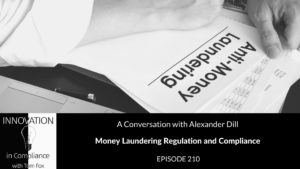
Tom Fox welcomes back Alexander Dill on this week’s episode of the Innovation in Compliance Podcast. Alexander is a lecturer at UCLA, as well as an author and advisor, specializing in financial regulation, risk management, and compliance. Alexander and Tom talk about anti-money laundering and the key problems compliance professionals encounter.
The Importance of Compliance Ratings Compliance Systems
Compliance rating systems were created to measure accuracy and integrity. After the events of Enron and WorldCom, there was a general criticism of credit rating agencies. Moody’s Investors Service, where Alexander spent a considerable amount of time working, got a great deal of that criticism due to the organization’s poor ratings performance and its lack of fraud rating. Moody’s wanted to continue to self-regulate as opposed to being regulated by the global regulators, and so the creation of these compliance systems helped with that. Alexander explains that the initial work that was done with respect to the ratings systems, helped lay the foundation for compliance when it became heavily regulated after the financial crisis of Dodd Frank.
The Compliance Regulators
Tom asks Alexander to explain the different types of regulators and what OFAC is. The main regulator for compliance is FinCen, which is the Financial Crimes Enforcement Network. FinCen is the primary rule making authority but delegates supervisory and examination authority to other agencies. Alexander goes on to list the other regulatory agencies. The regulatory agencies overlap, however the conflict that arises is that their objectives often do not align. “Banking agencies are focused on safety and soundness, and the law enforcement authorities spearheaded by FinCen focus on the law enforcement objective, so those don’t always come together in a uniform manner,” Alexander remarks.
The Role of Corporate Governance and Risk Management
The main role of corporate governance in anti-money laundering is to maximize shareholder welfare. Corporate governance systems are designed to protect franchise value. The systems cover all material risks that arise from conflicts of interest within agencies. Risk management is important to anti-money laundering as it is a component of corporate governance. Alexander stresses that the risk management function should fit into the corporate governance framework to be effective.
COVID-19 and Beyond
The pandemic has impacted the field of anti-money laundering and compliance in many ways, but perhaps the most notable way is that it enhanced fraudulent schemes. With a great deal of the world’s population migrating online, it opened up the pathway for various cyber attacks and cyber related crimes. COVID-19 unfortunately created various opportunities for people to exploit online platforms. Alexander hoped that in the future the Anti-Money Laundering Act that was introduced last year 2020, will begin to bear fruit and that red tech innovation and machine learning will help to curb these issues.
Resources
Alexander Dill | LinkedIn | Twitter
Check out Professor Dill’s book, Anti-Money Laundering Regulation and Compliance here.






